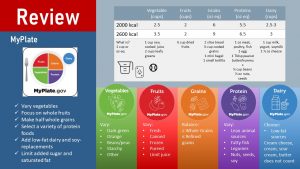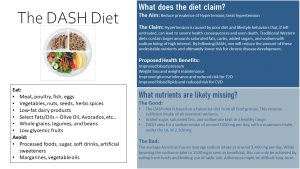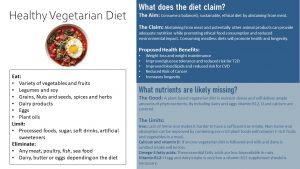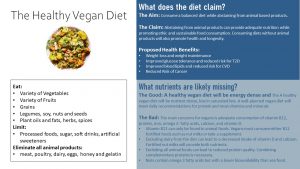36 Activity Resource: Recommended Eating Patterns
Eric Hanzel; Sabine Zempleni; and Peyton Millard
Scientists, medical and nutrition professionals use the nutrient based Dietary Reference Intakes (DRIs) to determine the adequacy of a diet or come up with meal plans. Many diet apps do the same and tracking nutrient intake to meet all recommendations on a daily basis is today the goal of many consumers. When it is so easy to check your diet for adequacy why do we need eating pattern recommendations?
The first problem is that this approach suggests an accuracy that is not there. Per definition DRIs are set (if possible) to meet the needs of 97 – 98 % of the American population. This approach is great for professionals but most Americans are not automatically nutrient insufficient if they do not meet the DRIs. An estimated 2 – 3% of Americans are nutrient insufficient even if they meet the recommendations.
So, the first problem is that we cannot determine for sure how much of a nutrient an individual person needs. We set recommendations so high that almost everybody is covered.
Using this approach there is a second issue. The eaten foods need to be converted into nutrient intake. For this purpose a nutrient data base such as USDA’s Food Data Central is used. The problem is that the nutrient content of a specific food is an average. For example the vitamin C content of 100 apples varies widely. Some apples are eaten immidiately after harvesting when the vitamin C content is high. Other apples are stored for a year losing vitamin C, a nutrient sensitive to light and oxygen, continuously. Different types of apples have varying vitam C contents. This means that this conversion from food to nutrient is an estimate.
Professionals know how to interpret those imprecisions but for daily eating this approach would be far too complicated. Using a nutrient tracking app will suggest a precision that is not there.
Out of this conundrum the consensus grew to develop rather a meal and food group oriented system for Americans. Following these recommendations delivers sufficient amounts of nutrients and promotes health.
The development of such a practical, flexible system started in the early 1920s century and lead over several other system—Basic Seven, Basic Four, Food Wheel, Food Guide Pyramid, MyPyramid—to the development of MyPlate in 2011. MyPlate, based on the Dietary Guidelines, is today the blueprint for the US eating recommendations, nutrition education and food policy. Here is a review of the basic concept:

This chapter will give you an overview over the recommended eating patterns:
The Dietary Guidelines are the basis for the US food policy including nutrition recommendation. Recommended Eating patterns based on the DG are:
- Healthy American eating pattern such as MyPlate and DASH
- Healthy Mediterranean eating pattern
- Healthy vegetarian eating pattern
The Dietary Guidelines Recommend Three Eating Patterns: Healthy American, Mediterranean, And Vegetarian Eating Patterns
While earlier Dietary Guidelines tended to focus on nutrients and food groups it is now commonly acknowledged that nutrients and foods are not eaten in isolation. People eat a combination of foods in form of an eating pattern. The DGAC identified three healthy eating patterns to prevent obesity and chronic diseases. These three eating patterns were adopted and recommended by the Dietary Guidelines:
- Healthy American eating pattern (MyPlate, DASH)
- Healthy Mediterranean eating pattern
- Healthy vegetarian/vegan eating pattern
DASH Diet
History of the Diet
The Dietary Approaches to Stop Hypertension or DASH diet was introduced in 1992 by the National Institute of Health (NIH). The development of DASH was sparked by the rise in chronic disease such as obesity, CVD, and Type II Diabetes in the mid to late 1900’s. When setting aside genetic factors, these diseases were positively correlated with an increased consumption of typical Western diets and processed foods – high saturated fats, carbohydrates, added sugars, and sodium.
While the ultimate goal of DASH is to reduce all chronic disease, the fiet was initially designed to focus on reducing hypertension. As you read in the CVD chapter, hypertension is interrelated with other chronic disease and, if not taken care of, can lead to severe health consequences and death thus making it the primary target of this diet. Since the DASH diet was introduced in 1992, the health benefits have been established by extensive research.

The Scientific Evidence
Since its introduction, DASH has been extensively researched and supported by many of the nations top health organizations such as the National Institute of Health, American Heart Association, and National Heart, Lung and Blood Institute. While there are currently no studies scetching the health impact of lifelong adherence to the DASH diet the research available consists of many intervention studieslong- and short-term, that consistently support weight loss, blood lipid control, improved insulin resistance and glucose tolerance, and reduced risks of CVD and high blood pressure.
In Summary
The DASH diet has made bounds and leaps in the scientific community and has become one of the top diets for reducing hypertension and improving overall quality of life. The DASH diet has not been around long enough to study life-long impact but the scientific evidence has created a solid foundation. It is safe to say that DASH does indeed reduce blood pressure and induce weight loss. DASH can be safely recommended for hypertensive adults and has even seen effectiveness for at-risk adolescents.
Mediterranean Diet
History of the Diet
Think of what a typical poor American college student’s diet looks like today. Many may think of eating ramen noodles, boxed mac-n-cheese, and McDonald’s in order to save money. Back a thousand years ago, the poor citizens of countries that surrounded the Mediterranean Sea ate bread, oil, wine, sheep cheese, and various vegetables (lettuce, mushrooms, leeks).
Over time trader contributed sugar cane, citrus, spinach, eggplant, rice, spices and many more. The major discovery of America by Europeans brought the tomato to Europe and established it as symbol of the Mediterranean cuisine. The discovery also introduced potatoes, corn, and peppers.
All of the events shaped the Mediterranean cuisine as it’s known today. The Mediterranean diet today is characterized by high consumption of veggies, fruits, grains, legumes, fish, eggs, little meat, ample amounts of olive oil, and wine.
In contrast to the DASH diet, the Mediterranean diet is an eating pattern that grew organically using foods that were traditionally available or suitable for the climate. Incidentally, this eating pattern is connected with one of the highest longevity in the world. Once scientists discovered this feature the Mediterranean diet spread through the world due to being healthy and delicious.

The Scientific Evidence
The Mediterranean Diet has been the forefront of dietary recommendations alongside the DASH diet. However, the Mediterranean diet has been around far longer than the DASH thus most of the long-term effects have been established. Researchers have found strong evidence supporting weight loss, blood lipid control, insulin sensitivity and glucose tolerance, and reduced risk of CVD and high blood pressure. Some studies have explored other potential benefits of the diet as well, with some suggesting improved cognitive function and reduced risk of certain types of cancer. These claims will need to be studied further but are nonetheless promising.
In summary, the Mediterranean Diet has been well studied and can be safely recommended to anyone. Keep in mind though that the Mediterranean diet is part of a culture that also includes ample amounts of daily physical activity and a mindful, slower lifestyle that reduces stress. The Mediterranean is a great option, but might culturally not be the optimal eating pattern for all Americans.
Healthy Vegetarian Eating Patterns
History of Vegetarian and Vegan Diets
Plant-based diets are nothing new. In fact, most historians believe that humans have been practicing meatless diets since before recorded history! Tomatoes and onions can’t run away or fight back so why not?
While the rational for going meatless has definitely changed since, the first recorded advocate for vegetarianism was Pythagoras in ancient Grecian times who gave meaning for going meatless. Pythagoras and his followers did so for religious and ethical reasons which was mainly enforced by the belief that all living beings had souls and should not be killed for consumption.
These early pioneers help to set the foundation for modern vegetarianism which was introduced around the mid-1800’s. The health benefits had yet to be identified but it was founded on similar ideas to Pythagoras with many Eastern religions and influential people like Mahatma Ghandi having practiced modern vegetarism for some time already. Buddhism, Hinduism, and Jainism carried on Pythagorean ways of thinking in the form of karma- what goes around comes around. Ill-treatment of animal (killing for consumption) is considered bad karma and will result in ill-treatment of the person who committed the action thus these religions refrained from eating meat on most occasions. Judaism and Eastern Christianity were not exactly staunch advocates for vegetarianism but believed that animal cruelty and inhumane killing were prohibited practices and thus vegetarianism was widely accepted.
Eventually these ideas reached America with many westernized religions supporting vegetarianism. None of these however, truly embodied the vegetarian way of life like the Seven-Day Adventist. Founders of this religion in 1863 combined the ideas of its vegetarian predecessors and created a strict diet that abstained from “unclean” foods – inhumanly slaughtered animals, pork, rabbit, and shellfish. While some Seventh-Day Adventists abstain from meat completely, some will eat “clean” and kosher animal products – humanely raised and slaughtered animals, chicken, fish, and some red meat. Overall, we could say that vegetarianism was initially founded on religious and moral values that finds many similarities across religious and cultural beliefs.
On the other hand, when compared to its close relative the vegetarian, vegans extend their dietary limitations to abstaining from all animal products including meat, dairy, eggs and sometimes honey and gelatin. Vegans also extend the avoidance of all animal products to wearing or using other animal products such as leather, wool, pearls, and even lotions and soaps.
The vegan lifestyle finds similar roots to its meatless ancestor Pythagoras but wasn’t truly defined until 1944. Donald Watson, a British woodworker, was the first pioneer of modern veganism and created a society that separated the lacto-ovo-vegetarians from those that completely abstained.
It wasn’t until the 1960’s when plant based diets truly became mainstream and accepted more widely. By this time, clinical studies had been well under-way to test the implications of plant-based diets on health. You could probably guess that researchers have found many benefits of going meatless since they have been increasingly advocated for, especially after the turn of the 20th century.
However, many people choose this lifestyle to benefit the environment since studies have shown how industrialized animal consumption can lead to poor environmental outcomes. Whatever the reason, it seems going meatless could actually reap many benefits. Today we have defined two types of plant-based diets – vegetarianism and veganism which will both be covered below.
Vegetarian Diets
Even though meat is excluded from the diet, vegetarians still have diverse options to help meet nutritional needs. However, the diversity of options depends on the type of vegetarian.
The standard vegetarian would be considered a lacto-ovo-vegetarian, “lacto” meaning dairy and “ovo” meaning egg. This means that a vegetarian will include eggs and milk in their diet. Consumers can choose to exclude one or both from their diet and would be considered lacto-vegetarians (only includes dairy), or ovo-vegetarians (only includes eggs).
Abstaining from one or both animal products will require a consumer to obtain nutrients from other sources. With good food knowledge vegetarians should have no problem meeting nutritional needs and living a long, healthy life. In fact, the vegetarian Seven-Day Adventists community in Loma Linda, California has one of the highest longevity in the world.

The Scientific Evidence for Vegetarian Diets
Vegetarian Diets, much like the previous two, have been well studied and show consistent, beneficial results. Researchers have found that Mediterranean diets support weight loss, blood lipid control, improved insulin sensitivity and glucose tolerance, and reduced risk of CVD and high blood pressure. Some studies have also found reduced risk of cancer development, similar to the Mediterranean diet.
One of the leading concerns with plant based diets, aside from adequate nutrient intake, is the development of Osteoporosis, a disease that results in decreased bone density and strength. In spite of eliminating animal product rich nutrients like vitamin B-12, vitamin D, or protein, researchers have only found little evidence suggesting that vegetarians are at a slightly higher risk for developing this disease. As stated before, vegetarians have exceptional longevity and the large majority will never succumb.
In summary, the vegetarian diet is a safe and sustainable way to meet daily nutrient intake and improve physiological function. Most research has been conducted in clinical settings and over the long-term allowing the vegetarian diet to be safely recommended. Those who are already deficient in certain vitamins and minerals such as iron, vitamin B-12, vitamin D, and sometimes iodine may need to work with a dietitian to make sure they are meeting all nutrient needs.
The Vegan Diet
Today, there are two types of vegan diets- the standard vegan and the raw vegan diet.
Vegans on a raw vegan diet will consume 75-100% of their non-animal products uncooked. Foods are not heated over 104 degree. Food preparation of grains and legumes involves soaking and sprouting. Vegetables are often fermented, seeds and nuts ground to butters or extracted in nut milks.
A raw vegan diet cannot be considered a healthy vegetarian diet. Cooking plant food breaks up cell walls and increases the bioavailability of nutrients. The lack of cooking makes the food hard to digest and lowers the bioavailability of many nutrients substantially.
The standard vegan diet will require a solid understanding of plant foods and nutrients. Vegans also must either consume vitamin B12 enriched foods or take a vitamin B12 supplement. The following information relates to the standard vegan diet.

The Scientific Evidence for Vegan Diets
Vegan diets exhibit almost identical research findings to that of the vegetarian diet. Researchers have found that Mediterranean diets support weight loss, blood lipid control, improved insulin sensitivity and glucose tolerance, and reduced risk of CVD and high blood pressure. Some studies have also found reduced risk of cancer development, similar to the Mediterranean diet.
Vegans however, are at higher risk of developing osteoporosis. If the diet is followed correctly and nutrients are obtained from fortified sources or supplements, vegans can obtain similar bone density levels to that of omnivores. If done incorrectly, vegans can be at a substantially higher risk for developing osteoporosis than vegetarians.
In summary the vegan diet is another safe and sustainable way to meet daily nutrient intake and improve bodily parameters. The vegan diet has been somewhat less studied than vegetarian diets but plenty of clinical and long-term studies have been conducted to give veganism a seat at the table of quality and safely recommended diets. Overall, plant-based diets are some of the healthiest out there but transitioning into them can be difficult due to the amount of restrictions. However, in recent years many supermarkets and even restaurants have started to include plant-based options to meet the demands of a growing vegetarian and vegan population here in the US.


Feedback/Errata